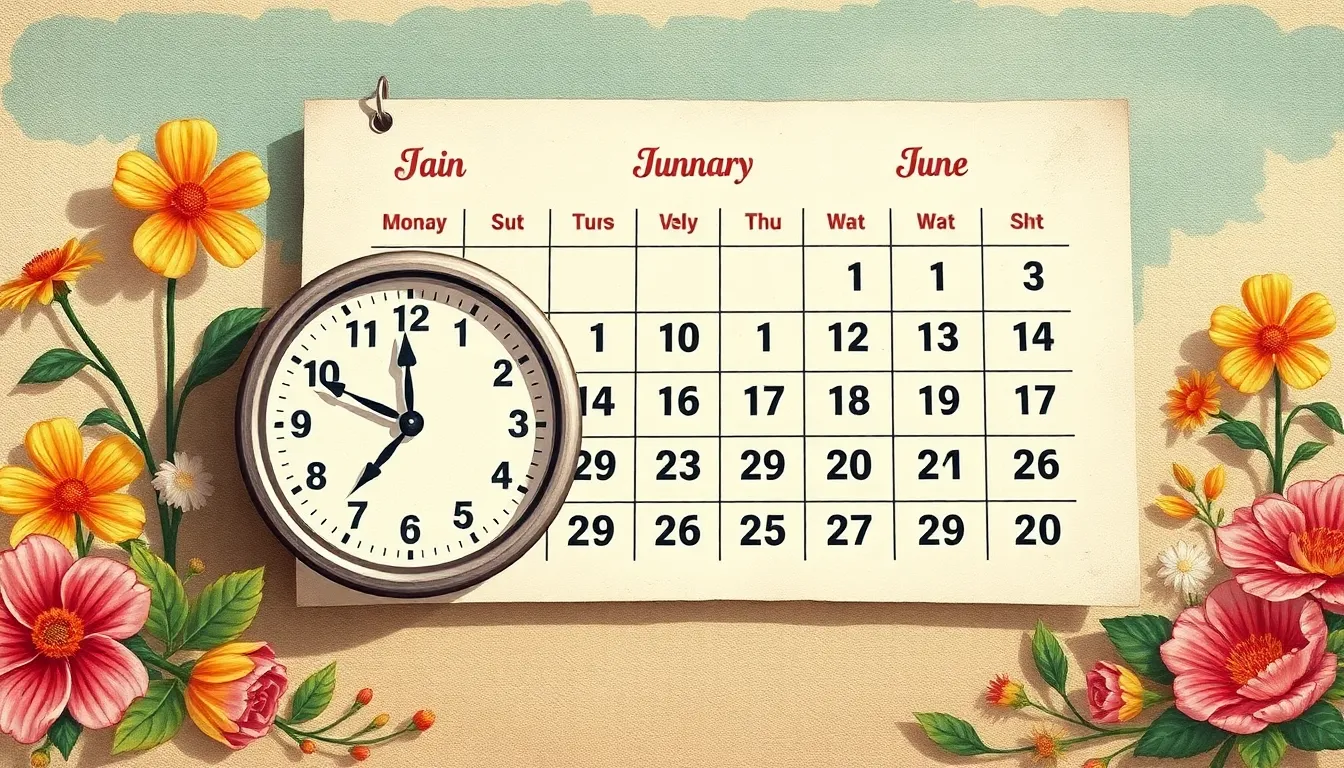Ever wondered how many days are in half a year? It’s a question that might seem simple, but it can spark some serious debate—especially among those who can’t remember if they’ve already celebrated their half-birthday. Spoiler alert: it’s not as complicated as trying to figure out how to fold a fitted sheet!
Table of Contents
ToggleUnderstanding Half a Year
Calculating half a year typically involves understanding the total number of days in a year. A standard year contains 365 days, while a leap year has 366 days. Therefore, half a year comprises either 182.5 days in a standard year or 183 days in a leap year.
Determining half a year can create confusion, especially during leap years. Leap years occur every four years, making specific years significant. For instance, 2020 and 2024 are leap years, ensuring the need for awareness in calculations.
Using a simple approach, one can round to the nearest whole number. In standard years, half a year equals 182 days, while in leap years, it’s 183 days. To mark or celebrate events that fall halfway through a year, it’s prudent to note the specific year in question.
Remembering that February 29 exists only during leap years helps clarify this calculation. When planning important dates or birthdays, readers can account for these variations.
Tracking half a year aids in understanding various time-related concepts. Calendar years, planning events, and calculating ages often require knowledge of exact days. Thus, knowing whether a specific year is a leap year can enhance planning accuracy.
Ultimately, half a year roughly translates to either 182 or 183 days based on the type of year. This understanding simplifies many aspects of time management and celebration planning.
Calculating Days in Half a Year

Calculating the number of days in half a year requires examining the differing lengths of standard and leap years.
The Standard Year
A standard year consists of 365 days. To find half of a standard year, divide this total by two. The result is 182.5 days. For practical purposes, rounding this value gives 182 days. This rounding simplifies event planning or birthday celebrations, as individuals can easily grasp the time frame. Recognizing that most years are standard years aids in understanding how half a year translates into manageable increments.
Leap Year Considerations
Leap years introduce an extra day, totaling 366 days. When calculating half a leap year, divide this number by two. This division results in 183 days, making leap years unique. Every four years, this extra day on February 29 affects calculations and celebrations. Individuals born on this day may encounter special considerations during planning. Events scheduled during leap years typically require awareness of this additional day, ensuring accurate timelines and age calculations.
Implications of Days in Half a Year
Understanding the number of days in half a year becomes essential for various practical purposes. This span impacts planning and scheduling activities.
Planning and Scheduling
Planning events and personal commitments hinges on accurately calculating half a year. Most people use the rounded figures of 182 days for standard years and 183 days for leap years. Organizing birthdays, anniversaries, or vacations requires awareness of these specifics. Some may exploit the additional day in leap years for unique celebrations. Seasonal events, such as holidays or festivals, often fall within this timeframe. Efficient scheduling ensures that individuals accommodate their personal agendas and avoid conflicts. Proper understanding of half a year aids in structuring meaningful timelines and enhancing overall time management strategies.
Financial Quarterly Reports
Financial reporting relies heavily on dividing the year into manageable parts. Corporations typically report quarterly, with each quarter covering three months, equating to roughly 91 or 92 days. Thus, half a year spans two quarters, or six months. Companies prepare mid-year financial assessments based on this breakdown. Stakeholders depend on these insights to track performance, adjust budgets, and make informed decisions. Timely reports ensure that businesses stay competitive in the market. With half a year covering 182 or 183 days, organizations effectively monitor progress and set goals for the remaining fiscal year.
Fun Facts About Half a Year
Half a year comprises approximately 182 or 183 days, depending on whether it’s a standard or leap year. Rounding simplifies the numeral to 182 days in a standard year and to 183 days in a leap year. Leap years occur every four years, adding an extra day in February. Individuals born on February 29 celebrate their birthdays only once every four years, which makes their half-birthday particularly distinct.
Corporations use half a year for financial assessments, which typically divide the year into quarters. Mid-year evaluations occur after two quarters, allowing businesses to analyze performance. Planning events, like vacations or anniversaries, often considers this timeframe for better organization.
Numerous cultural celebrations, including holidays and festivals, align with the six-month mark. Different cultures recognize events such as Midsummer or the Summer Solstice, highlighting the significance of the seasons. Understanding half a year aids in historical comparisons, such as measuring progress within yearly goals or projects.
Some sports seasons also reference half-year timelines, emphasizing their frequency in league play. This recognition assists fans in following their favorite teams and gauging their performance accurately. In education, half a year may indicate a semester, affecting course planning for students and educators alike.
Half a year’s time frame serves as a critical marker in both personal and professional contexts. Recognizing these fun facts can inspire better planning, facilitate celebration timing, and enhance awareness of organizational timelines.
Understanding how many days are in half a year is essential for effective planning and organization. Whether it’s for personal celebrations or professional assessments, knowing that half a year consists of approximately 182 days in a standard year and 183 days in a leap year can simplify scheduling.
This knowledge helps individuals and businesses alike navigate timelines with confidence. Recognizing the significance of half a year in various contexts—from birthdays to financial reporting—can enhance time management strategies. Embracing this clarity allows for smoother transitions through the year and ensures that important events are never overlooked.




